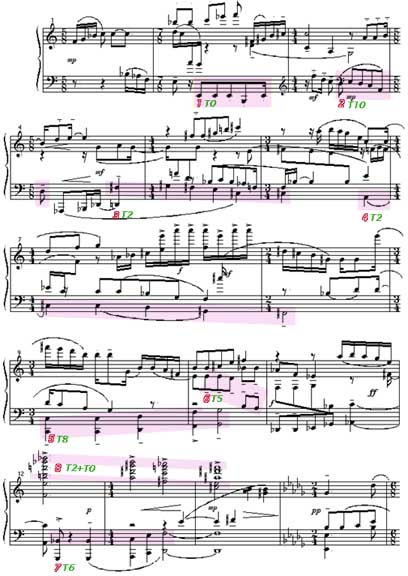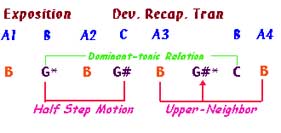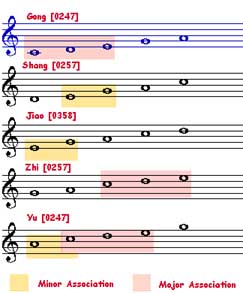Analysis of Which Side Are You On
from
Fredrick Rzewski's Four North American Ballads

Email: liang_you@yahoo.com
Analysis of Which Side Are You On
from
Fredrick Rzewski's Four North American Ballads

Email: liang_you@yahoo.com
| Form | Diatonic material in Chromatic settings | Minor 2nd Relationship | Pentatonic Scale Rotation | Texture | Tonal Plan | Transposition Level | Tune |
Rzewski's "North American Ballads" is a set of four pieces based on the union tunes These pieces are an outgrowth of the "new populism", which abandons the serialism and sought to be understood by a larger public. Although his melodies come from popular culture, he handles them in a strict classical formal structure with the technique of a sophisticated Baroque contrapuntist, yet in a late-twentieth century manner. Rzewski’s chromatic settings of the diatonic material, especially the use of half-step relationships in both vertical and linear perspectives is one of the most striking aspects in this set of four pieces. His second piece of the set, "which side are you on?" shows a wide divergence of characters, such as minimalism, collage-quotationalism and neo-Romanticism. Its highly complex polymodal contrapuntal style contrasts and compliments the exceptionally simple tune. Rzewski’s use of symmetry is not only presented in the four-note motific cell [0257] but also in its formal structure in its tonal plan.
The large structure of "Which side are you on?" is in a Sonata-Rondo form.(See Ex. 1) The C section is the center of the arch-shaped structure. On each side of C there are two polymodal A sections. The arch is completed by two diatonic A section appearances at the beginning and the end.
Ex. 1. Formal Structure
| Sonata Form A (Exposition) | B (Development) | A (Recapitulation) | |||||||||
| Rondo Form | Intro | A1 | Tran. | B | A2 | C | Retran | A3 | Tran. | B | A4 |
| Key | B | C | G | B | G# | F# | B | G# | C | B | |
| Measure | 1 | 26 | 34 | 37 | 43 | 51 | 69 | 75 | 89 | 92 | 131 |
The introduction does not start on its home key B minor. The tune is quoted in bass line with each segment in the original order through different transposition level starting on E minor. (See Ex. 2). Ex..2.T0=E
| Transposition | #1 | #2 | #3 | #4 | #5 | #6 | #7 | #8 |
| Key | E | D | F# | F# | C | A | Bb | F# |
| Voice | Bass | Bass | Bass | Bass | Bass | Alto | Bass | Hightest+Lowest |

The segments are labeled 1-8. 7 and 8 is the repetition of 5 and 6 in the original tune. Note that segment 3, 4 and 8 are in T2, which is F# minor, the Dominant of home key B minor. The pattern of the transposition levels is either 2 semitones or multiples of 2 semitones apart except for 6. In fact, the transposition levels compress itself with a multiple of 2 semitones in contrary motion within an octave. The distance between each transposition becomes smaller in arch shape until it meets the middle of the octave, which is the tritone, T6. Its symmetrical transposition plan in this passage creates an arch shape. (See Ex. 3).
Ex. 3
This example shows that Bb is the center of this arch form. From T0 (E) to T10 (D) is ten semitones apart; from T10 (D) down to T2 (F#) is eight; from T2 to T8 (C) is 6. The index number of the transposition level for segment 6 should be T4 (G#) but instead, we have T5 (A). This alternation in half-step recalls the vertical chromatic setting of the diatonic segments in the beginning measures (tenor’s Eb against E in the bass). The pattern resumes in segment 7 when it reaches T6 and simultaneously segment 8 concludes the opening section with returning to T0.(New Music For Piano: Figure 88. Kathleen Supove, Piano. ©Composers Recordings, Inc.) (Top)
Rzweski quotes the tune Which side are you on? four times with the increasing texture in its original key, B minor, which holds the Rondo form together in this piece. This tune makes it first entrance in the simplest diatonic manner with an exact imitation a fifth below in alto voice (m 22). After a polymodal transition, the return of A only quotes the second half of the tune in its original key (mm43). While the left hand presents the tune vertically with chords in the lowest register, the right hand plays segments from the first half of the tune in polymodal fashion at the opposite extreme register. The use of the extreme register contrasts from the first appearance, which only uses the middle range of the register with all voices in close position. The third appearance is polymodal with distorted rhythm. Stretto is conspicuous in the first six segments of the tune. The last two segments of the tune, which is the repetition of the segment 5 and 6, are presented in their augmentation form in order to relax the tension from the climax earlier. Rzewski almost covers the whole keyboard in this passage. Our ears are dazzled with entrances of segments in extreme registers. The final appearance of the tune (m131) returns to its original diatonic version, however, this time is in ff and Rzewski certainly needs to use all of the registers on the keyboard for a grand conclusion. (Top)
The tonal plan for the rest of the sections are even more intriguing. Rzewski uses submediant as a mean of substituting dominants. the B section in exposition is in G minor, which is submediant of its home key B. After a brief statement of the quotation A2, the development moves to the key of G#. This is a good example of the linear use of the half-step relationship. (See Ex. 4) The return of the B section in recapitulation, however, is not in its original key of B but in C. Why is this not in its original key like the traditional sonata form? This question again leads us to the linear half-step key relations.
Ex. 4. Dominant-Tonic Relation

This is a monothematic piece. The only way to produce contrast between A and B section is through modification of tonalities and textures. Rzewski conceived this successfully by using the key of C as a linear presentation the minor 2nd key relations. C functions as an upper-neighbor gesture between section A3 and A4. It also creates a Dominant-Tonic relationship as in the traditional sonata form. G (B section in Exposition) is the dominant of C (B section in Recapitulation). (See Ex. 4). Therefore, in a way the B section is in its "relatively home key". Meanwhile, the texture changes from extremely polyphonic to monophonic; the constantly changing of metersfinally calms down to static 4/4time. The tune is now presented in a mechanical minimalistic style in order to set up for the grand finale.
*submediant relations (VI-I) substitute the dominant relation (V-I). (Top)
Rzewski's clever and thoughtful use of the chromatic relationships within the frame of classical form shows his extraordinary compositional craftsmanship. Presenting the same material in a minor 2nd tonal relationship simultaneously creates great uncertainty of tonalities. This conflict between the distant sharp-oriented and flat-oriented keys reflects the title of the piece"Which side are you on?" Sharp side or flat side? (Top)
Diatonic Material in Chromatic Setting
Rzewski juxtaposes diatonic materials in a chromatic setting both vertically and linearly. It makes a clear statement as early as the very beginning this piece. The entrance of tenor voice is clearly in Eb. The statement of the tune in the bass is, however, in E. presents. A vertical example is shown in mm22-25, the transition to A1, the primal presentation of the tune. The top voice remains in Bb minor from mm15-21 while the bass moves on to a new key, B minor, in which the union tune will be presented. This is an excellent transition by using minor 2nd relationship vertically to connect two sections with distant key relations.
The conflict is not only shown in its key relations but also within the tune itself. We will start by examining its modal quality. The tune is based on a minor-oriented pentatonic scale. The pentatonic scale can be rotated in five different forms. In Chinese folk music we have five names for each rotations. These are Gong, Shang, Jao, Zhi and Yu. Each of them has its own major or minor associations determined by the first four notes of the scale. Here is a chart how it works: (in C)
| Name | Scale | Scale Pattern | Position | Association | Set Type* |
| Gong | C-D-E-G-A | 3+2 | Root | Major | [0247] |
| Shang | D-E-G-A-C | 2+2+1 | 1st Inversion | Minor | [0257] |
| Jao | E-G-A-C-D | 1+2+2 | 2nd Inversion | Minor | [0358] |
| Zhi | G-A-C-D-E | 2+3 | 3rd Inversion | Major | [0257] |
| Yu | A-C-D-E-G | 1+3+1 | 4th Inversion | Minor/Major | [0247] |
*--The set types for the first four notes (tetrachord) of each scale

.
According to this chart, Gong and Yu share the same set type, which is [0247]. Yu is the inversion of Gong. Yu's characteristics have both minor and major associations. Shang and Zhi share the symmetrical set [0257]. They can map on each other through transposition. Zhi is T5 of Shang. Because of the subset [04] (major third), [0247] has the implication of being a major key. In a like manner, [03] (minor third) in [0257] hints its association with minor. [0257] is the most important motific cell in which side are you on?. (Top)
The half-step interplay of [0247] and
[0257] continues to be a way of representing the symbolic meaning of the title.
The tune has four phrases and the fourth phrase is the repetition of the third.
Each phrase contains two segments. The fifth segment in the original tune is
B-B-D-E-F# [0247], which has a major mode implication. The sixth
segment answers with a descending F#-F#-E-C#-B (a set type of
[0257]), which is in a minor mode. We should not leave out the fourth segment,
which contains both D and C#. D is used in ascending purposes and C# only appears
in the descending phrases. The ascending segment is likely to be a question
and the descending segment seems to be the resolution of the question. (See
Ex. 5) However, the text "which side are you on?" is set in both ascending
and descending segments. The uncertainty of major-minor mode and the question-answer
confusion further suggest the title of this tune--"which side are you on?"
Ex. 5
 Click
here to play it.
Click
here to play it.
Rzewski takes this matter one step further. He has altered the D to C# in the fifth segment both the ascending (fifth) and descending (sixth) segment share the same pitches, as well as the set type [0257] . Because of this change, four-note group appears five times in the quotations. This set becomes the most important motific cell that ties the whole piece together. It seems as if he solved the conflict by staying with only the minor mode, however, Rzewski recreates conflicts by using [0247] in a descending context instead of ascending as it is in the original.
A similar example can be found in mm86-87, which combines two set types together with A-B as a pivot point. The overlap starts with [0257] in B (minor). The A-B in measure 86 becomes the ending of [0257] as well as the starting point for [0247]. Again, Rzewski altered the role of the ascending and descending segments. The "question" turns into the "answer", however, with the set type of the "question". The confusion makes it even harder to decide which side we are on.
The use of extreme registers these Ballads presents extraordinary colors of different contrapuntal layers. The combination of the Baroque contrapuntal style, the Romantic triadic figuration, the 20th century polymodal and minimalistic writing creates great varieties based on a simple folk tune and yet, still keeps its political symbolic meanings. Bartok once commented on the role of quotation in music:
Liang-Yun You

Education
BM, 1995, Oberlin Conservatory of Music.
Artist Diploma, 1997, Oberlin Conservatory of Music.
MM, 1999, The Juilliard School.
DMA in progress, Moores School of Music, University of Houston.
Major Teachers:
Sedmara Rutstein (Oberlin Conservatory of Music).
Jerome Lowenthal (The Juilliard School).
Nancy Weems (Moores School of Music)
Teaching Experience
Private Piano Lessons in all levels
Ear Training Teaching Fellowship, The Juilliard School 1998-1999
Class Piano Teaching, San Jacinto College 1999-2000
Faculty of Preparetory and Continuing Study, Moores School of Music, 1999-Present